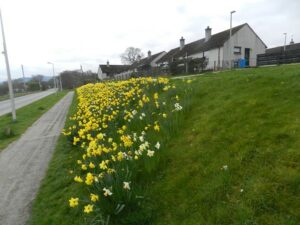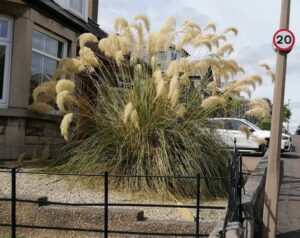2022 County Report for East Sutherland
Mick Crawley
In 2022 a concerted effort was made to determine which of the daffodil cultivars were most frequent on banks and roadsides away from gardens in East Sutherland. It turns out that the list is very similar to that which would be found almost anywhere else in Great Britain, with the commonest taxa, in ranked order, Narcissus 'Ice Follies', N. 'Golden Harvest', N. 'Carlton', N. 'Princeps', N. × 'Tête-à-tête', N. 'Jetfire', N. 'Fortune', N. 'Dutch Master', N. 'Telamonius Plenus', N. 'February Gold', and N. 'Saint Keverne'.
As in other parts of Scotland, Cortaderia richardii (Early Pampas-grass) is much more frequently naturalised than is C. selloana (Pampas-grass), and is recorded increasingly often in sand dunes, on roadsides and in open waste ground. The original colonists are clearly garden-escapees (see below) but several self-replacing populations are turning up. Unlike C. selloana, the bisexual plants of C. richardii are self-compatible.
No new native plant species were recorded in 2022, but the first record of Centaurea debeauxii (Slender Knapweed) for v.c. 107 was made at Drummuie (NH8198499645) in a verge sown with a wildflower mix (i.e. deliberately planted). All other records of C. nigra s.l. for East Sutherland are of C. nigra s.s. (Common Knapweed) which should be regarded as the only native taxon.
Erophila glabrescens (Glabrous Whitlowgrass) proved to be more frequent in 2022 than previous records had suggested. It had a very singular jizz, with its flowers held much closer to the ground than in E. verna (Common Whitlowgrass) and apple-green, shiny leaves.

